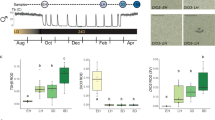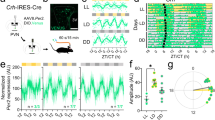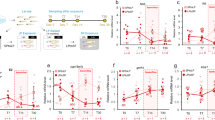Abstract
CHANGES in daylength are principally responsible for synchronising breeding with time of year in mammals and birds1: for example, ferrets begin to breed in spring and oestrus ends in autumn. Oestrus can be provoked by exposure to long photo-periods (such as 14 h light: 10 h dark, LD 14 : 10) during winter2 and can be terminated prematurely if short photo-periods (LD 8 : 16) are given during summer3. The pineal is essential for both effects, which are prevented by removal of the gland3,4 or its autonomic nerve supply5 from the superior cervical ganglia (C.A.Y. unpublished results). The pineal contains large concentrations of the transmitter 5-hydroxytryptamine (5-HT), which has been implicated in the neural control of circadian rhythms, which themselves may be related to the genesis of annual rhythms1. In the pineal of the rat concentrations of 5-HT vary in phase with photoperiod, and this rhythm is prevented by ganglionectomy6. Inhibition of cerebral 5-HT synthesis prevents circadian rhythms in concentrations of both plasma adrenal corticosteroids7 and luteinising hormone8. Lesions of the suprachiasmatic nuclei, which contain large concentrations of 5-HT9,10, abolish circadian rhythms in eating and drinking11, in running12 and in concentrations of pineal n-acetyltransferase13, which is the rate limiting enzyme in the synthesis of melatonin, a putative pineal hormone. The pineal must transmit information about photoperiod to neural structures regulating the pituitary, but the nature of the link is unknown. We report here that exposure of ferrets to either long or short photoperiods induces differential 5-HT rhythms in the pineal and hypothalamus, which are abolished by autonomic denervation, and that melatonin induces 5-HT rhythms characteristic of animals kept in short photoperiods.
This is a preview of subscription content, access via your institution
Access options
Subscribe to this journal
Receive 51 print issues and online access
$199.00 per year
only $3.90 per issue
Buy this article
- Purchase on Springer Link
- Instant access to full article PDF
Prices may be subject to local taxes which are calculated during checkout
Similar content being viewed by others
References
Sadlier, R. M. F. S., The Ecology of Reproduction in Wild and Domestic Mammals (Methuen, London, 1969).
Bissonnette, J., J. exp. Biol., 12, 315–320 (1935).
Thorpe, P. A., and Herbert, J., J. Endocr. (in the press).
Herbert, J., J. Endocr., 43, 625–636 (1969).
Abrams, M. E., Marshall, W. A., and Thomson, A. P. D., Nature, 174, 311 (1954).
Snyder, S. H., Zweig, M., Axelrod, J., and Fischer, J. E., Proc. natn. Acad, Sci. U.S.A., 53, 301–305 (1965).
Scapagnini, U., and Preziosi, P., Prog. Brain Res., 39, 181–183 (1973).
Hery, M., Laplante, E., and Kordon, C., J. Endocr., 67, 463–464 (1975).
Saavedra, J. M., Palkovits, M., Brownstein, M. J., and Axelrod, J., Brain Res., 77, 157–165 (1974).
Fuxe, K., Z. Zelforsch, 65, 573–579 (1965).
Stephan, F. R., and Zucker, I., Proc. natn. Acad. Sci. U.S.A., 69, 1583–1586 (1972).
Stetson, M. H., and Watson-Whitmyre, M., Science, 191, 197–199 (1976).
Moore, R. Y., in The Neurosciences Third Study Program (edit. by Schmitt, F. O., and Worden, F. G.), 537–542 (MIT Press, London, 1974).
Fiske, V. M., and Huppert, L. C., Science, 162, 279 (1968).
Anton-Tay, F., Chou, C., Anton, S., and Wurtman, R. J., Science, 162, 277–278 (1968).
Herbert, J., in The Pineal Gland, Ciba Foundation Symposium (edit. by Wolstenhelme, G. E. W., and Knight, J.), 303–327 (Churchill Livingstone, London, 1970).
Klein, D. C., in The Neurosciences Third Study Program (edit. by Schmitt, F. O., and Worden, F. G.), 509–515 (MIT Press, London, 1974).
Kordon, C., Neuroendocrinology, 4, 129 (1969).
Domanski, E., Przekop, F., Skubiszewski, B., and Wolinska, E., Neuroendocrinology, 17, 265–273 (1975).
Bunning, E., Cold Spring Harb. Symp. quant. Biol., 25, 249 (1960).
Lofts, B., and Lam, W. L., J. Reprod. Fert., Suppl., 19 (1973).
Ahtee, L., Sharman, D. F., and Vogt, M., Br. J. Pharmac., 38, 72–85 (1970).
Author information
Authors and Affiliations
Rights and permissions
About this article
Cite this article
YATES, C., HERBERT, J. Differential circadian rhythms in pineal and hypothalamic 5-HT induced by artificial photoperiods or melatonin. Nature 262, 219–220 (1976). https://doi.org/10.1038/262219a0
Received:
Accepted:
Published:
Issue Date:
DOI: https://doi.org/10.1038/262219a0
This article is cited by
-
Impact of a single, short morning bright light exposure on tryptophan pathways and visuo- and sensorimotor performance: a crossover study
Journal of Physiological Anthropology (2018)
-
Annual variations in brain serotonin and related compounds of domesticated rainbow trout (Oncorhynchus mykiss)
Fish Physiology and Biochemistry (1992)
-
Differential effects of photoperiod and temperature on hypothalamic monoaminergic activity in the teleost Channa punctatus (Bloch)
Fish Physiology and Biochemistry (1990)
-
Changes with darkness in regional brain 5-hydroxytryptamine and 5-hydroxyindole acetic acid: Local differences with pinealectomy, sham surgery, and melatonin
Neurochemical Research (1989)
-
Diurnal variations in hypothalamic monoamine levels in the teleostChanna punctatus (bloch) in response to melatonin under two photothermal conditions
Fish Physiology and Biochemistry (1988)
Comments
By submitting a comment you agree to abide by our Terms and Community Guidelines. If you find something abusive or that does not comply with our terms or guidelines please flag it as inappropriate.



